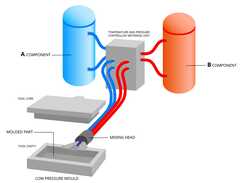Poly(dicyclopentadiene) (pDCPD) molding process by reaction injection molding (RIM). pDCPD has similar mechanical properties to engineering thermoplastics and is used as an alternative to aluminum and glass fiber reinforced polyester composites.
Thus, like polyurethane, the resin is formed by a system of two liquid components: an activator and a catalyst. The two reactant streams are mixed and injected into a closed mold, in which the polymerization of dicyclopentadiene (DCPD) takes place. The components are mixed in a 1:1 ratio and the material can cure immediately or take up to 2 minutes. The process takes place in aluminum or steel molds, without the use of release agents and the piece, after being molded, goes to the painting line. Molding takes place at low temperatures, in cycles lasting from 2 to 6 minutes.
All material processing can be done on standard equipment used for polyurethane (PU) RIM molding. However, some adjustments need to be made, since the process must take place under total absence of oxygen.
An atmosphere of nitrogen coats the equipment, which must be subjected to internal ionization and pressurization with the gas. The mold also needs to have a good seal and can be pressurized with nitrogen, depending on the system used.
The system can be used to replace PU in the manufacture of parts with a high degree of structuring, using less raw material.
Although the material is indicated to manufacture large and/or thick parts, manufactured in small and medium scales, pDCPD can be used in the manufacture of small parts, as long as the cost-benefit of the process is evaluated. The raw material's low viscosity (0.3 Pas) allows its molding under low pressure (from 15 to 30 psi) and allows the filling of all cavities of a complex mold, giving designers greater design autonomy.

It is estimated that less than 10% of heavy vehicles are produced with reactive injection molded pDCCD parts. The company Telene launched a grade of pDCPD reinforced with mineral fibers, in which the fiber is inserted in the molding process as a third component of the system and that can be adapted to receive a coating inside the mold, eliminating the part finishing step. and further increasing the strength of the material.

Parts made of this material have a low water absorption, have an ideal surface for painting application and employ low injection pressure, which provides faster production.
“ The technology guarantees the production of an extremely resistant part, both to chemicals and to impact, superior in mechanical properties to parts obtained by techniques already used in the market, in addition to being lighter. It is an evolution to be used in fairings, bumpers, fenders, hoods and other parts for tractors, buses, trucks, earth moving machines, automobiles and motorcycles.”
The manufacture of parts in pDCPD, made by RIM, consists of the injection of two chemical components, dosed through a specific equipment for the process, which are mixed in an injection head in closed molds by a system of hydraulic presses. Resin is still a novelty in the country and the potential this technology has for the Brazilian market, mainly in the automotive sector, since it is indicated for the manufacture of large parts. Although injection services are already performed in Brazil, activities related to the engineering and production of molds are still carried out in Italy.
Fonte: Plástico Industrial





